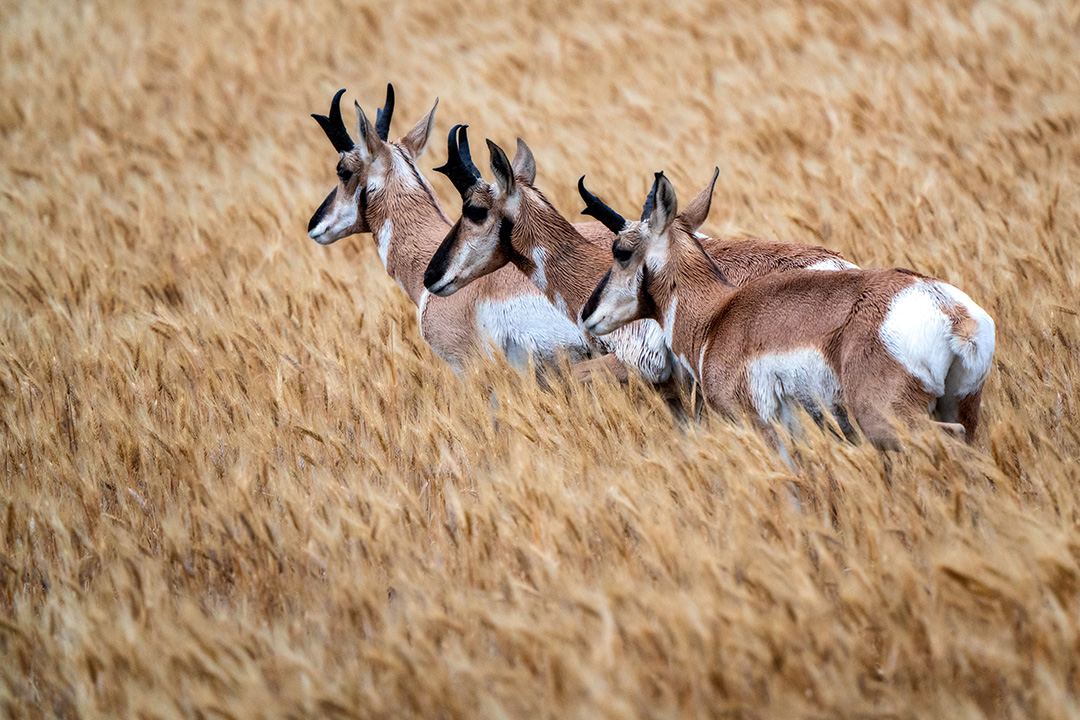
USask researchers test alternative anesthetic protocol for sedating pronghorn
A research team at the Western College of Veterinary Medicine (WCVM) is working to find a reliable method of sedating North America’s fastest land mammal: the pronghorn.
By Jessica ColbySimilar in size and appearance to deer, pronghorn are ungulates (hoofed animals) that are related to goats and antelope. The horned animals are known for their swiftness: adult pronghorn can travel at close to 100 kilometres per hour and maintain their speed over a long distance.
“The whole physiology of the [pronghorn’s] heart and lungs are meant to be able to run at highway speeds,” says Dr. Barbara Ambros, who led the research team.
Besides their speed, pronghorn are also well known for their flightiness. The smallest disturbance — even a light breeze stirring up some leaves — will cause the herd to flee.
“I think that the strong physiology paired with their flightiness makes them really hard to anesthetize,” says Ambros, a professor and anesthesiologist in the WCVM’s Department of Small Animal Clinical Sciences.
Opioids are a family of pain-relieving drugs commonly used in anesthesia, and etorphine is one particular opioid that wildlife researchers have previously used to immobilize pronghorn. Since the pronghorn’s physiology makes them more challenging to sedate, veterinarians must use a relatively large dose — nearly five milligrams of etorphine — to successfully sedate the 40-kilogram animal.
In comparison, veterinarians can safely sedate a 1,000-kg rhinoceros with 2.5 mg of the opioid — less than half the dose used to sedate a pronghorn.
However, etorphine is now restricted in Canada because of its high potency. No one can import the opioid into the country without a special authorization from Health Canada.
As a result, scientists are working to find another reliable method of effectively sedating these animals.
“[There’s] a greater need for us to explore different protocols,” says Ambros.
“Using less potent opioids is also safer for the handlers,” says Dr. Jennifer Pelchat, a resident in veterinary anesthesiology and Master of Science student.
As she explains, etorphine used in the quantities required to sedate wild animals can be fatal to humans.
“We needed to find a new way to sedate these animals with a different drug protocol,” says Pelchat.
Working with a small herd of pronghorn that live year-round at the Saskatoon Forestry Farm, the WCVM team tested the current anesthesia protocol — a combination of etorphine-medetomidine-midazolam-azaperone (EMMA) — against a new drug protocol that includes butorphanol, azaperone and medetomidine (BAM).
Pelchat was responsible for recording sedation scores, collecting blood and determining recovery scores. Included in the sedation scoring was any excitement before each pronghorn went down and how long it took the animal to become sedated.
Ambros emphasizes that due to their flightiness, pronghorn cannot be manually restrained and must be sedated for any type of hands-on procedures such as dental examinations and hoof care.
“Using the etorphine-based protocol, we were able to achieve suitable sedation,” says Dr. Bruna Hech, another WCVM anesthesiology resident and master’s student. “However, this opioid causes severe respiratory depression, along with the fact that etorphine access is very limited in Canada.
“Finding a protocol that offers minimal cardiovascular and respiratory depression effects provides better quality anesthesia and more security for the team and for the patient.”
Hech helped to calculate the volume for the anesthetic drugs used, collected data and blood samples in the field and analyzed the sedated animals’ blood gases. She will also be helping to develop a research abstract and manuscript outlining the study’s results.
“[The study] will provide a little bit more information for those people that still can use potent opioids in pronghorn to really reinforce that we need to supplement oxygen,” adds Ambros.
The study was “a great team effort,” says Ambros. In addition to the WCVM anesthesiologists, the research team included the college’s avian, exotic and wildlife medicine specialists as well as Dr. Kamal Gabadage, a member of the WCVM Veterinary Medical Centre’s ruminant field service team. Gabadage provided dental care and hoof trimming services to the immobilized pronghorn during the study. Zookeepers at the Saskatoon Forestry Farm also contributed their expertise to the wildlife study.
The research team’s work is important to provide people who work with wildlife or conduct wildlife research the possibility to have alternative sedation protocols, says Ambros.
“This research can help other veterinarians around the world deliver the best immobilization for the captive pronghorn,” adds Hech. “The literature is very spare in this field and more publications in this area are welcome.”
The Western College of Veterinary Medicine's Wildlife Health Research Fund (WHRF) provided financial support for this study.
